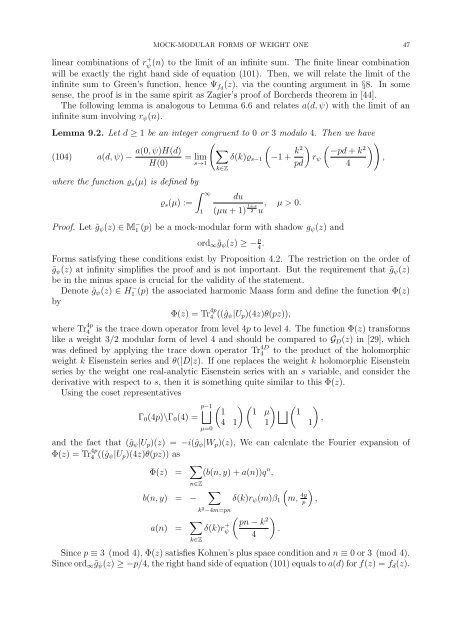Mock-modular forms of weight one - UCLA Department of Mathematics
Mock-modular forms of weight one - UCLA Department of Mathematics
Mock-modular forms of weight one - UCLA Department of Mathematics
You also want an ePaper? Increase the reach of your titles
YUMPU automatically turns print PDFs into web optimized ePapers that Google loves.
MOCK-MODULAR FORMS OF WEIGHT ONE 47<br />
linear combinations <strong>of</strong> r + ψ<br />
(n) to the limit <strong>of</strong> an infinite sum. The finite linear combination<br />
will be exactly the right hand side <strong>of</strong> equation (101). Then, we will relate the limit <strong>of</strong> the<br />
infinite sum to Green’s function, hence Ψ fd (z), via the counting argument in §8. In some<br />
sense, the pro<strong>of</strong> is in the same spirit as Zagier’s pro<strong>of</strong> <strong>of</strong> Borcherds theorem in [44].<br />
The following lemma is analogous to Lemma 6.6 and relates a(d, ψ) with the limit <strong>of</strong> an<br />
infinite sum involving r ψ (n).<br />
Lemma 9.2. Let d ≥ 1 be an integer congruent to 0 or 3 modulo 4. Then we have<br />
(<br />
a(0, ψ)H(d) ∑<br />
( ) ( ) )<br />
(104) a(d, ψ) − = lim δ(k)ϱ s−1 −1 + k2 −pd + k<br />
2<br />
r ψ ,<br />
H(0) s→1 pd 4<br />
k∈Z<br />
where the function ϱ s (µ) is defined by<br />
ϱ s (µ) :=<br />
∫ ∞<br />
1<br />
du<br />
(µu + 1) 1+s<br />
2 u , µ > 0.<br />
Pro<strong>of</strong>. Let ˜g ψ (z) ∈ M − 1 (p) be a mock-<strong>modular</strong> form with shadow g ψ (z) and<br />
ord ∞˜g ψ (z) ≥ − p 4 .<br />
Forms satisfying these conditions exist by Proposition 4.2. The restriction on the order <strong>of</strong><br />
˜g ψ (z) at infinity simplifies the pro<strong>of</strong> and is not important. But the requirement that ˜g ψ (z)<br />
be in the minus space is crucial for the validity <strong>of</strong> the statement.<br />
Denote ĝ ψ (z) ∈ H − 1 (p) the associated harmonic Maass form and define the function Φ(z)<br />
by<br />
Φ(z) = Tr 4p<br />
4 ((ĝ ψ |U p )(4z)θ(pz)),<br />
where Tr 4p<br />
4 is the trace down operator from level 4p to level 4. The function Φ(z) trans<strong>forms</strong><br />
like a <strong>weight</strong> 3/2 <strong>modular</strong> form <strong>of</strong> level 4 and should be compared to G D (z) in [29], which<br />
was defined by applying the trace down operator Tr 4D<br />
4 to the product <strong>of</strong> the holomorphic<br />
<strong>weight</strong> k Eisenstein series and θ(|D|z). If <strong>one</strong> replaces the <strong>weight</strong> k holomorphic Eisenstein<br />
series by the <strong>weight</strong> <strong>one</strong> real-analytic Eisenstein series with an s variable, and consider the<br />
derivative with respect to s, then it is something quite similar to this Φ(z).<br />
Using the coset representatives<br />
Γ 0 (4p)\Γ 0 (4) =<br />
p−1<br />
⊔<br />
µ=0<br />
(<br />
1<br />
4 1<br />
) (<br />
1 µ<br />
1<br />
) ⊔<br />
(<br />
1<br />
1)<br />
,<br />
and the fact that (ĝ ψ |U p )(z) = −i(ĝ ψ |W p )(z), We can calculate the Fourier expansion <strong>of</strong><br />
Φ(z) = Tr 4p<br />
4 ((ĝ ψ |U p )(4z)θ(pz)) as<br />
Φ(z) = ∑ n∈Z(b(n, y) + a(n))q n ,<br />
b(n, y) = − ∑<br />
a(n) = ∑ k∈Z<br />
k 2 −4m=pn<br />
δ(k)r + ψ<br />
δ(k)r ψ (m)β 1<br />
(m, 4y p<br />
( pn − k<br />
2<br />
Since p ≡ 3 (mod 4), Φ(z) satisfies Kohnen’s plus space condition and n ≡ 0 or 3 (mod 4).<br />
Since ord ∞˜g ψ (z) ≥ −p/4, the right hand side <strong>of</strong> equation (101) equals to a(d) for f(z) = f d (z).<br />
4<br />
)<br />
.<br />
)<br />
,
















